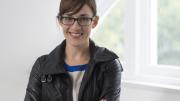From glowing fish to bacteria that can count, synthetic biologists are now able to create life forms never before seen on earth. “Historians and Ecclesiastes be damned,” says Sophia Roosth, assistant professor in the history of science. “In the first decades of the twenty-first century, a number of things are new under the sun.”
In a lecture last Wednesday drawn from her forthcoming book, Synthetic: How Life Got Made, Roosth, a Joy Foundation Fellow this year at the Radcliffe Institute for Advanced Study, described her analysis of recent attempts at “de-extinction,” the effort to recreate extinct or endangered species using modern technologies. In 2003, scientists employing a technique similar to that used to create Dolly the sheep were able, if only temporarily, to resurrect the extinct bucardo, or Pyrenean ibex, by inserting its DNA into the eggs of its closest living relatives—goats—and then implanting the resulting embryos in the wombs of 57 goats. (The only clone born alive died minutes after birth.) “Participating researchers treat these biotechnologies…as forms of biological time travel that weave past, present, and future,” Roosth said.
Other de-extinction efforts take a different approach, she noted. Although some scientists are working to resurrect the passenger pigeon through cloning, for example, others have focused on breeding and genetically modifying rock pigeons to exhibit passenger-pigeon-like traits. The second approach, said Roosth, brings up the complex question of what biologists consider a species. “For de-extinction scientists, purity of phenotype—things like morphology and behavior—trumps genetic equivalence or continuous lineage,” she explained. “An animal that looks and flocks like a passenger pigeon is a passenger pigeon, even if it harbors rock pigeon DNA.”
Roosth ended by describing Pleistocene Park, a nature reserve in Siberia where scientists are working to restore the steppe ecosystem characteristic of the last Ice Age. Current efforts focus on reintroducing large herbivores like musk oxen, bison, and moose, and, eventually, their predators, such as wolves and bears. The park hopes to become home one day to resurrected woolly mammoths as well. Roosth quoted Winthrop professor of genetics George Church, a leader of the mammoth de-extinction effort, who wrote in his book Regenesis: How Synthetic Biology Will Reinvent Nature and Ourselves, “It would be the closest thing to time travel: a return to the flora and fauna of the Pleistocene epoch, a sort of latter-day Siberian Eden.”
Ironically, there is nothing natural about the reconstructed wilderness, Roosth points out. Appearance and verisimilitude, the hallmarks of a resurrected passenger pigeon, become the defining characteristics of an entire ecosystem. “[These] interventions seek to produce wholly synthetic creatures that will stand in, counterintuitively, as semblances of untouched nature,” she declared, “a latter-day Garden of Eden seemingly unsullied by human hands, albeit generated by the most recent bioengineering techniques.”
For more on de-extinction, read the recent New York Times magazine feature, “The Mammoth Cometh.”









